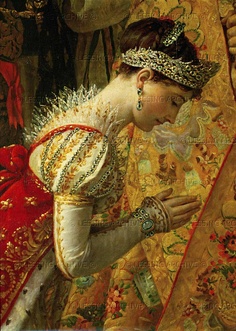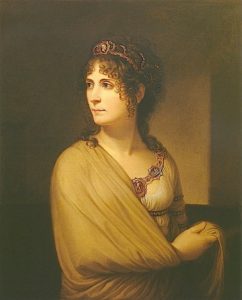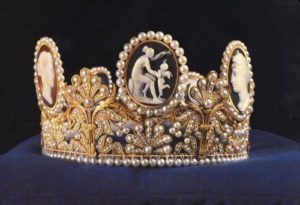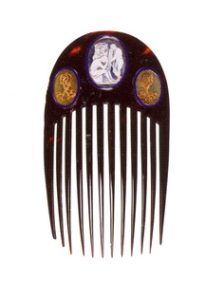Josephine’s Jewels: Fit for Empress
A modest beginning
The ring that young general Napoleon Bonaparte offered Josephine for their engagement in 1776 recently sold at auction for an astonishing $949,000. The winning bidder, allegedly a Russian who wishes to remain anonymous, paid almost 50 times the $20,000 the auction house Osenat had estimated. Adding Osenat’s 25 percent commission, the ring fetched $1.17 million.
“In my wildest dreams, I did not think we would outsell the estimate by more than 47 times,” said auctioneer Emily Villane. “We based the estimates in our catalog on the actual market value of the ring, minus Napoleon and Josephine provenance. It is not our job to tell bidders how much they should pay for the historical premium.”

The gold ring, in an 18th century setting called toi et moi (you and me), features two opposing pear-shaped gems: a blue sapphire and a diamond, each weighing a little less than a carat. Its provenance was confirmed by Jean-Christophe Chataignier, head of the Empire department at the auction house Osenat in Fontainbleau. The ring had been part of the collection of prince Victor Napoléon, grandson of Napoleon’s youngest brother, Jérôme, king of Westphalia, and his wife, the Princess Clementine of Belgium.
At the time of their courtship, Napoleon had limited means and buying the relatively modest alliance must have represented a very considerable expense. Josephine treasured the ring and it remained in her possession even after Napoleon divorced her and she owned a collection of jewelry of unparalleled magnificence.
Two days after their wedding on March 9, 1776, general Bonaparte assumed command of the army of Italy, and Josephine soon had the opportunity to enrich her jewelry collection. No sooner had she joined her victorious husband in Milan that she discovered there were many “pretty things for sale in Italy,” and began to acquire many of the jewels in which the country excelled, among them coral and cameos from Naples, mosaics and cameos from Rome, and numerous pieces inspired in the Greek and Roman antiquity.
The empress’s jewels: love and splendor
 As the emperor’s consort, Josephine was able to satisfy her love for beautiful jewelry. The diadem she wore at the coronation ceremony in Notre Dame Cathedral on December 2, 1804, was made especially for the occasion and was set all over with 1040 diamonds. Reputed to be one of her favorite pieces of jewelry, the diadem was inherited by her daughter, Hortense. It was auctioned by the French Republic in 1887 and bought by Van Cleef & Arpels, which owns it to this day.
As the emperor’s consort, Josephine was able to satisfy her love for beautiful jewelry. The diadem she wore at the coronation ceremony in Notre Dame Cathedral on December 2, 1804, was made especially for the occasion and was set all over with 1040 diamonds. Reputed to be one of her favorite pieces of jewelry, the diadem was inherited by her daughter, Hortense. It was auctioned by the French Republic in 1887 and bought by Van Cleef & Arpels, which owns it to this day.
 Another splendid tiara, made for Josephine by the FrNorwegian-emerald tiaraench jeweler Pabst, features geometric emeralds in a new classical diamond design, mounted on a frame of gold and silver. It is now worn by Norwegian royalty on major occasions and forms part of the Norwegian Crown Jewels.
Another splendid tiara, made for Josephine by the FrNorwegian-emerald tiaraench jeweler Pabst, features geometric emeralds in a new classical diamond design, mounted on a frame of gold and silver. It is now worn by Norwegian royalty on major occasions and forms part of the Norwegian Crown Jewels.
 Josephine had a particular love for cameos, and she is portrayed wearing them in a number of famous portraits, including this beautiful work by Andrea Appiani.
Josephine had a particular love for cameos, and she is portrayed wearing them in a number of famous portraits, including this beautiful work by Andrea Appiani.
Many of her cameos reflect her love for her husband and children. Portraits of Napoleon, Hortense, Eugene and her grandchildren were carved as cameos and mounted as the centerpieces of necklaces, belts, rings and medallions, sometimes enclosing a lock of hair.
 Josephine’s love of cameos undoubtedly inspired this tiara by Marie-Etienne Nitot. Rich pearls surround the medallions engraved by master artisans with classical figures, and underline the intricate design of honeysuckles, scrolls, and palmettos of the gold frame. It was inherited by Josephine’s son Eugene who gave it to his daughter, the empress’s granddaughter and namesake. Josephine married the future king Oscar I of Sweden in 1823. The tiara remains the property of the Swedish royal house and has graced the head of every reigning queen ever since.
Josephine’s love of cameos undoubtedly inspired this tiara by Marie-Etienne Nitot. Rich pearls surround the medallions engraved by master artisans with classical figures, and underline the intricate design of honeysuckles, scrolls, and palmettos of the gold frame. It was inherited by Josephine’s son Eugene who gave it to his daughter, the empress’s granddaughter and namesake. Josephine married the future king Oscar I of Sweden in 1823. The tiara remains the property of the Swedish royal house and has graced the head of every reigning queen ever since.
 While diamonds and precious stones were de rigueur at sumptuous Empire events, Josephine also loved less costly jewelry. She was very fond of coral, and bought it in every available color, from deep amber to the palest pink. Sometimes she had it carved into cameos, but often had it strung as bead in necklaces or earrings, mounted in tortoiseshell combs, or even used as buttons for clothing. She also owned many pieces featuring lapis lazuli, cornelian, amber, agate and turquoise.
While diamonds and precious stones were de rigueur at sumptuous Empire events, Josephine also loved less costly jewelry. She was very fond of coral, and bought it in every available color, from deep amber to the palest pink. Sometimes she had it carved into cameos, but often had it strung as bead in necklaces or earrings, mounted in tortoiseshell combs, or even used as buttons for clothing. She also owned many pieces featuring lapis lazuli, cornelian, amber, agate and turquoise.
Josephine’s selection of jewelry reflected her impeccable taste and she wore each piece with great distinction. She was in this supported by her husband, as Napoleon wished his wife to project an image befitting the grandeur of the Empire and often added to her collection. Josephine loved showing her treasures, and was very generous in bestowing them as gifts, not only upon her family and intimates but even upon casual acquaintances.
A Footnote to History: Josephine’s debts
Josephine has come down in history as someone who could never fully satisfy her passion for beautiful things. Exquisite dresses, opulent jewels, precious fabrics, and the softest Kashmir shawls. She was also a great collector and patron of fine arts, and her legendary collection of rare plants and animals was very expensive to acquire and maintain.
While it is well known that she spent freely and did not worry overmuch about how she would pay, it is also true that all her selections reflected an unerring taste, even if they did not always possess lasting value. Despite a very generous allowance conferred by Napoleon after their divorce, her spending could never keep pace with her income and she died leaving very substantial debts.
But was Josephine as irresponsible about money as some accounts claim? I have recently run into this passage from a biography by Ernest John Knapton (Empress Josephine, Harvard University Press, New York, 1963), which seems worth quoting to balance the historic record:
The widely quoted statement that Josephine died leaving debts of nearly three million francs, while literally true, is not the whole picture and is less than fair to her reputation. Shortly after her death, Eugène and Hortense undertook to divide their inheritance, and for this purpose authorized an elaborate inventory of all Josephine’s property, real and personal. In rounded numbers the inventory set the following value upon her possessions: classical antiquities and other sculptures, 230,000 francs; furniture, books, and musical instruments, 140,000 francs; paintings, drawings, and engravings, 990,000 francs; jewels, other precious objects, and real estate, 9,700,000 francs. When debts of nearly three millions were deducted from this total of eleven millions, the balance remaining for Eugène and Hortense amounted to over eight million francs. Few ‘spendthrifts’ have done better for their children.
This article Copyright © 2013 Sway Ways
